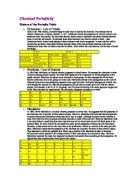2) Gallium can be considered as unusual due to its physical properties, many of which are not typical of a metal. Gallium has a melting point of 29.78ºc only slightly above room temperature in UK. Therefore in hotter countries Gallium becomes a liquid at room temperature like the metal Mercury. This is unusual as most metals are in a solid state at room temperature; only three liquid metals are found in the periodic table, mercury, caesium and gallium. Due to its low melting point and a high boiling point of 2403ºc Gallium has the widest liquid range of any element. Gallium has a liquid range of 2174.09 K in comparison with the metal Aluminium often described as having similar properties which has a range of 1858.53 K. Gallium is denser as a liquid than as a solid at its freezing point, similar to water. This is a property more typical to a non metal than a metal. The explanation for this is that the solid has a more open structure than the liquid. Gallium dissolves in both acids and alkalis, similar to the metal aluminium. It is unusual for a metal to behave in this way.
2Al + 6H 2Al + 3H
2Ga + 6H 2Ga + 3H
These equations show the similarities in the reactions of Gallium and Aluminium with hydrogen ions.
2Al + 2OH + 6H O 2[Al(OH) ] + 3H
2Ga + 2OH + 6H O 2[Ga(OH) ] + 3H
These equations show the similarities in the reactions of Gallium and Aluminium with hydroxide ions.
Metals which behave in this way have amphoteric hydroxides. The anhydrous trichloride of gallium has the molecular formula Ga Cl
3) The UNILAC accelerator is operated by scientists at GSI and offers a unique accelerator facility for heavy ions. It allows systematic investigation of all nuclear reactions that may conceivably produce super heavy elements. UNILAC consists of 120 m long linear accelerator. This process entails firing a beam of heavy ions from an accelerator at a target of a heavy stable element.
If this is carried out with enough violence the ions will fuse together, overcoming their natural repulsion and forming a new element. The newly formed elements are then separated and detected by a velocity filter (SHIP). This was first successful in 1981 with the creation of element 107.
Cr + Bi Element
The latest to be created is element 112 which was created in February when scientists smashed zinc ions into a rotating target of lead.
Zn + Pb Element
It is fundamental that scientists understand the structure of both the atoms they are potentially fusing together. The structure of the target element must be determined to ensure it is a heavy stable element.
The UNILAC is a 120m long linear accelerator brings the ions on track and accelerates them to 20 % of the velocity of light.
Target wheel itself is rapidly rotated to avoid overheating
Scientists also study atomic spectroscopy to increase the understanding of chemical elements. Atomic spectrometry is an analytical measurement method relying on the spectroscopic processes of excitation and emission. Atoms absorb and emit packages of electromagnetic radiation producing two types of spectra. An emission spectrum is produced when atoms become excited and move to a higher energy level. When the atoms return to ground state they emit electromagnetic radiation. The photon of energy emitted can be determined by the following equation:
E = hv
Energy of photon = Planck’s constant x frequency of light
This produces a spectrum consisting of coloured lines on a black background. The lines of the emission spectrum correspond to the different transitions between energy levels.
The emission spectrum for hydrogen
The sequence of lines in an atomic spectrum is characteristic to the atoms of the element, therefore scientists can use it to identify the elements present even if the element is present in a compound or is part of a mixture. In order to understand these spectrum scientists must make two basic assumptions (1) that of the infinite number of orbits an electron can make about a nucleus only certain discrete orbits actually occur. (2) that radiation is emitted or absorbed by a transition of the electron from one quantum sate to another. To successfully interpret the spectrum and identify the element scientists must have a sufficient understanding of atomic structure.
4) Over the last hundred years the work of scientists has been subject to dramatic change. In the mid nineteenth century the main aim of scientists was the discovery and classification of elements. During the nineteenth century scientists began to look for patterns of behavior between elements. Classification began with Döbereiner who attempted to classify elements using their atomic weights. Mendeleev advanced on this by not only classifying elements in terms of increasing atomic weights but left gaps for
undiscovered elements. In the twentieth century science reached a new era and moved away from the classification of elements. Instead the main focus was on the synthesis of new elements. Using UNILAC scientists can now synthesise new elements. Using SHIP scientists are now filtering out extremely rare fusion products. Due to the complexity of this task scientists are only able to detect around one superheavy nucleus per day from a flood of more that three thousand billion beam particles. The main aim for the future is to synthesise element 114 which is thought to be stable with a lifetime measured in years.
References
[1] Salter’s advanced chemistry course ‘Chemical Ideas’.
Oxford: Heinemann 1994
P.125 article: Atomic Spectra
[2] Atomic Spectra and atomic structure by Gerhard Herzberg.
New York: Dover publications 1945
P.14 article: Simplest Line Spectra and Atomic Theory.
[3]
[4] www.astro.uiuc.edu







